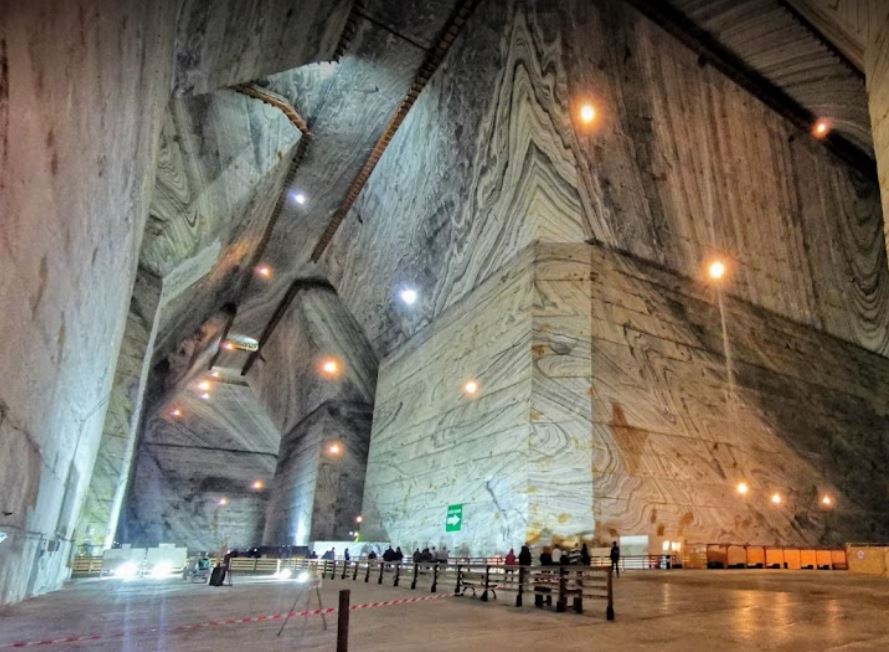
Found in Prahova County, Romania, Slanic Salt Mine presents a singular subterranean experience. Not utilized for extraction anymore, the mine is now a main draw for tourists. Its large halls and crisp, chilly air—which is thought to have restorative effects—draw visitors in.
Slanic Salt Mine Information
| Category | Details |
|---|---|
| Location | Slanic, Prahova County, Romania |
| Founded | 1688 |
| Owner | Salrom S.A. |
| Main Attractions | Unirea and Mihai Levels, Salt Sculptures |
| Website | Slanic Salt Mine |
Slanic Salt Mine’s Historical Background
The history of the mine begins in 1688 when Spătar Mihai Cantacuzino opened the salt extraction location. It developed over time among the most significant salt mines in Romania. Today, guests can discover its amazing past and large subterranean areas, presently exploited for tourism.
Slanic Salt Mine’s Structural Organization
Two main levels define Slanic Salt Mine: Unirea and Mihai. Unirea is well-known for its fourteen big trapezoidal chambers; Mihai just has six, but with amazing dimensions. One of the biggest salt mines in Europe, the huge subterranean area inspires wonder in every visitor.
Tourist Information Table
| Category | Details |
|---|---|
| Location | Slanic, Prahova County, Romania |
| Founded | 1688 |
| Owner | Salrom S.A. |
| Opening Hours | 9:00 AM – 3:45 PM |
| Main Attractions | Unirea and Mihai Levels, Genesis Hall, Salt Sculptures |
| Access | Minibuses from entrance to the chambers |
| Temperature | 12°C year-round |
| Activities Available | Recreational sports, table tennis, salt museum, aeromodeling contests |
| Health Benefits | Believed to improve respiratory conditions due to salt aerosols |
| Website | Slanic Salt Mine Website |
| Price Range | Prices vary depending on group size and tours; refer to the website for detailed pricing |
| Nearest City | 100 km north of Bucharest |
| Additional Features | Playgrounds, café with Wi-Fi, merchandise stalls |
| Recommended for | Families, history enthusiasts, sports fans, and those seeking therapeutic benefits |
Healing Qualities of the Mine Air
Slanic Salt Mine’s medicinal air quality appeals to many guests. Rich in aerosols, the microclimate of the mine is thought to ease respiratory problems. Its low humidity and consistent temperature create the perfect setting for healing and leisure.
From Extraction to Exploration
The Slanic Salt Mine has been turned into a tourist attraction since 1970 when salt extraction there came to an end. Visitors can tour its large rooms, appreciate salt sculptures, and even engage in leisure pursuits including table tennis and sports events nowadays.
Popular Travel Destination in Romania
Every year the mine draws thousands of tourists. Romania’s must-see location is this one since it combines health advantages, natural beauty, and historical background. Apart from giving a unique experience underground, the mine presents a remarkable window into Romania’s past.
Table of Reviews
| Reviewer | Review | Rating |
|---|---|---|
| Katie W | “Absolutely incredible. The mine’s chambers are breathtaking in size and beauty.” | 5/5 |
| Robert P | “A must-see in Romania. You can’t grasp the enormity until you visit in person.” | 4.5/5 |
| Daniel W | “The experience of entering the mine took my breath away. Worth the trip from Bucharest.” | 5/5 |
| Gabriella S | “Very spacious, relaxing, and fun. A unique and enjoyable visit.” | 4/5 |
| Steviefull | “A long trip from Bucharest, but the scale of the mine makes it worth every minute.” | 4.5/5 |
A Mine With Historical Value
Slanic Salt Mine has been rather important for Romania’s economy over ages. It developed as a significant center for salt production by the early 1900s. The efforts of Prince Barbu știrbei to upgrade the mine helped define its growth as a national industrial gem.
The Salt Museum, or Genesis Hall
Genesis Hall, one of the mines’ chambers, has become a salt museum. Visitors can observe salt-carved sculptures including historical figure busts of Trajan and Decebal. This cultural contribution improves the whole mine experience.
A Minibus Journey Into Slanic Depth
Using minibuses, which go well below earth, visitors can plunge inside the mine. Since 2014, the main elevator of the mine has been broken, hence minibuses provide a quick and secure access to the large rooms below. This accentuates the journey of visiting the site.
Sports and Events Inside the Mine
A few mine chambers have been converted for sporting activities. Sports fans find this place special since athletes use the roomy, cool surroundings for training. The peculiar site gives the activities carried out far below surface thrills more intensity.
Mihai Level Aeromodeling Competitions
Attracting both visitors and competitors, the Mihai level hosts national and worldwide aeromodeling events. These events offer an interesting variation on conventional contests and take place in the great subterranean venues. The scale of the mine is ideal for such kind of activity.
Slanic Salt Museum: Travelling Through History
Deeper investigation of Romania’s mining past is provided by the Slanic Salt Museum. Viewing historic mining tools and equipment, visitors can learn about the rich salt extraction legacy of the area. The museum offers an educational opportunity that accentuates the natural beauty of the mine.
FAQs about Slanic Salt Mine
- What is Slanic Salt Mine?
It’s a large salt mine in Romania, now a tourist spot with vast chambers. - How do you enter the mine?
Visitors take minibuses deep underground. - What can you do inside?
Explore chambers, see salt sculptures, and play sports. - What’s the temperature inside?
A constant 12°C year-round. - Are there health benefits?
The salt air is believed to help with respiratory issues.
